新概念英语第一册Lesson121-122课课件(共28张PPT)
文档属性
| 名称 | 新概念英语第一册Lesson121-122课课件(共28张PPT) | 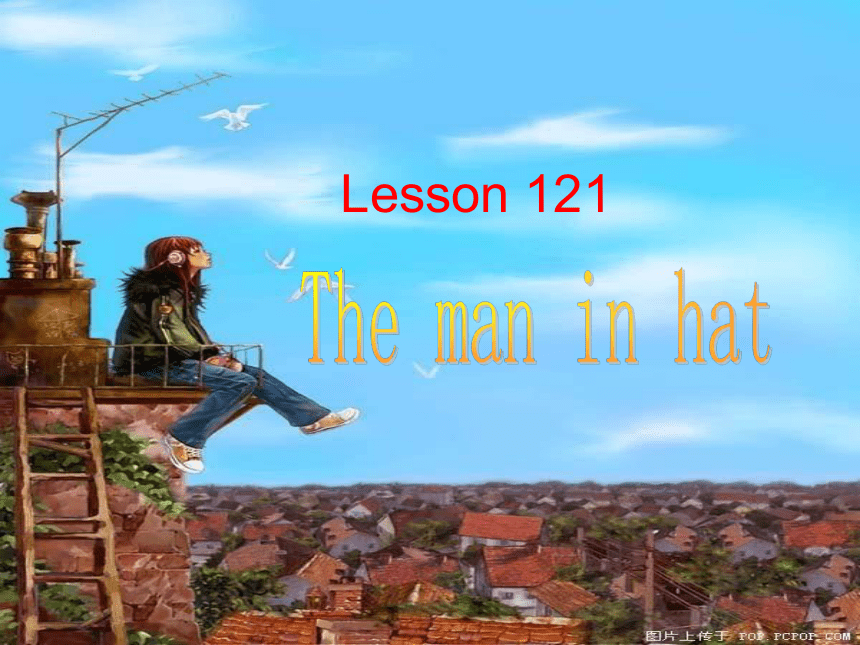 | |
| 格式 | ppt | ||
| 文件大小 | 2.8MB | ||
| 资源类型 | 教案 | ||
| 版本资源 | 新概念英语 | ||
| 科目 | 英语 | ||
| 更新时间 | 2024-04-09 09:48:32 | ||
图片预览

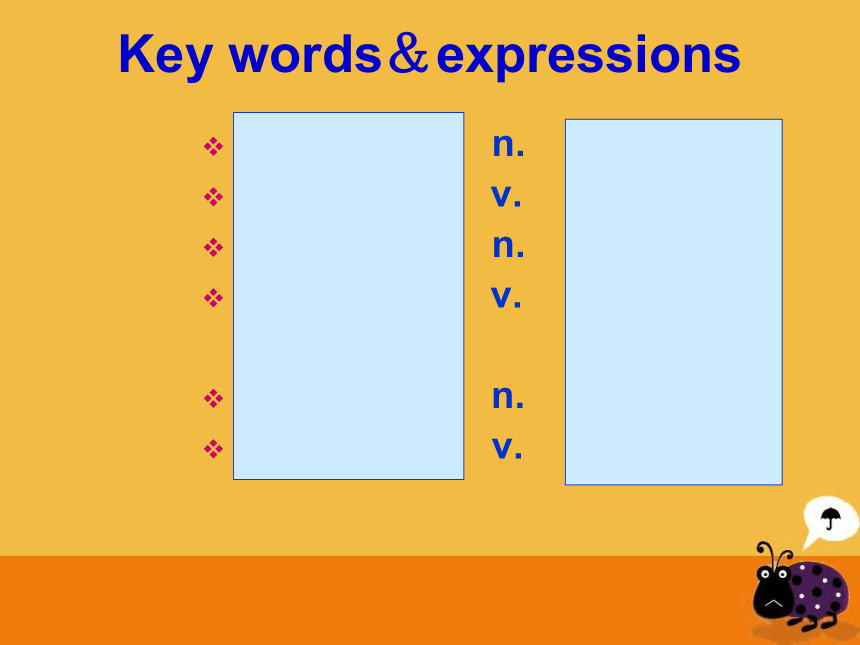
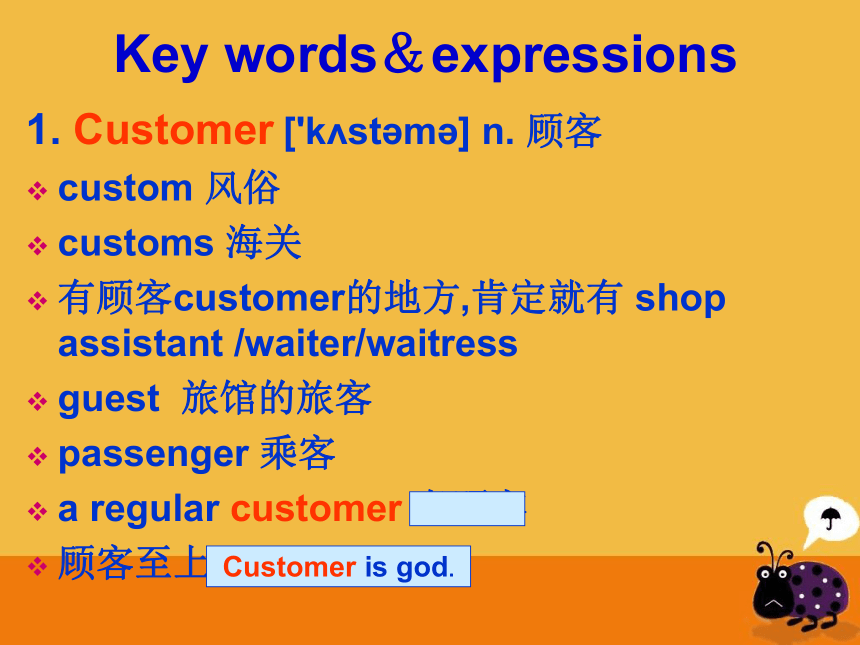
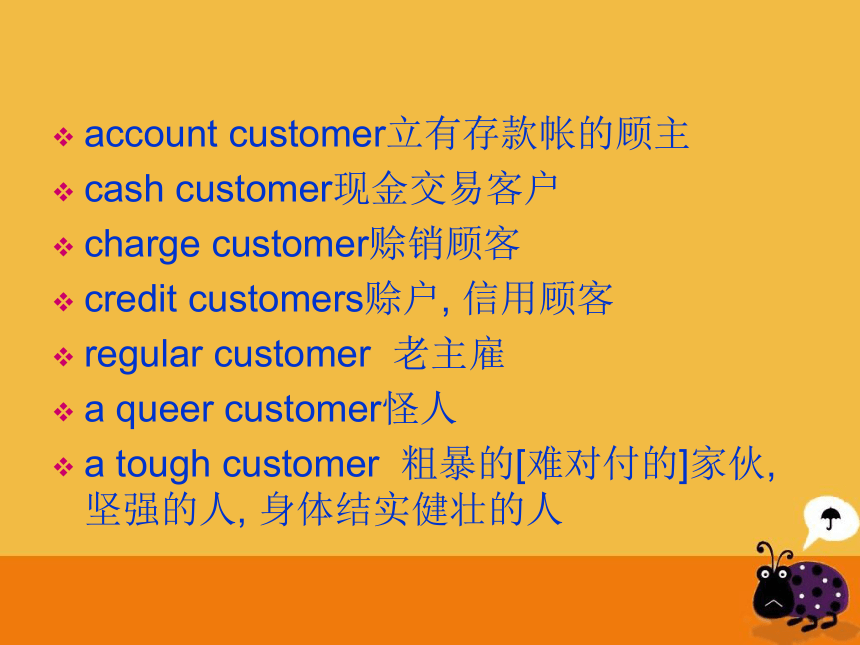
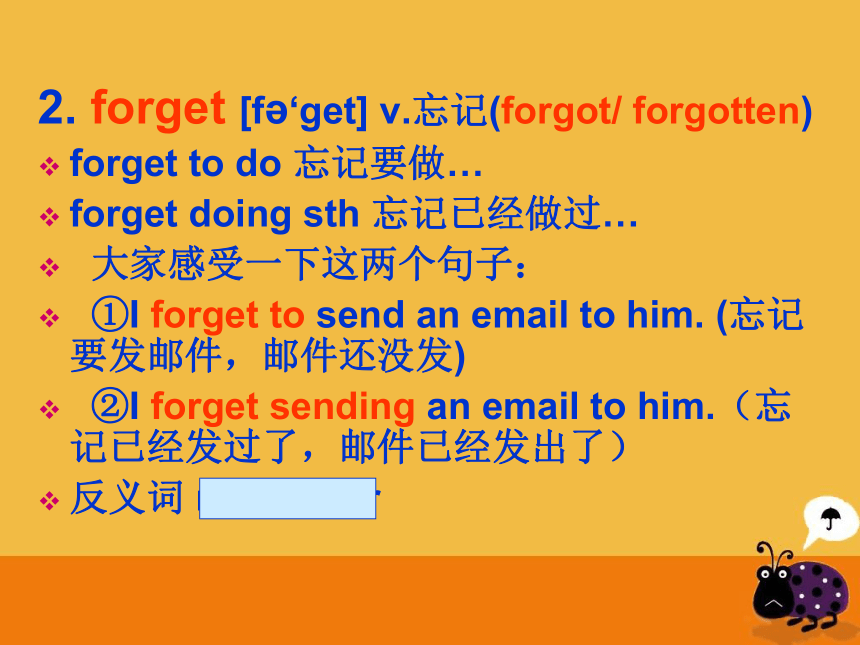
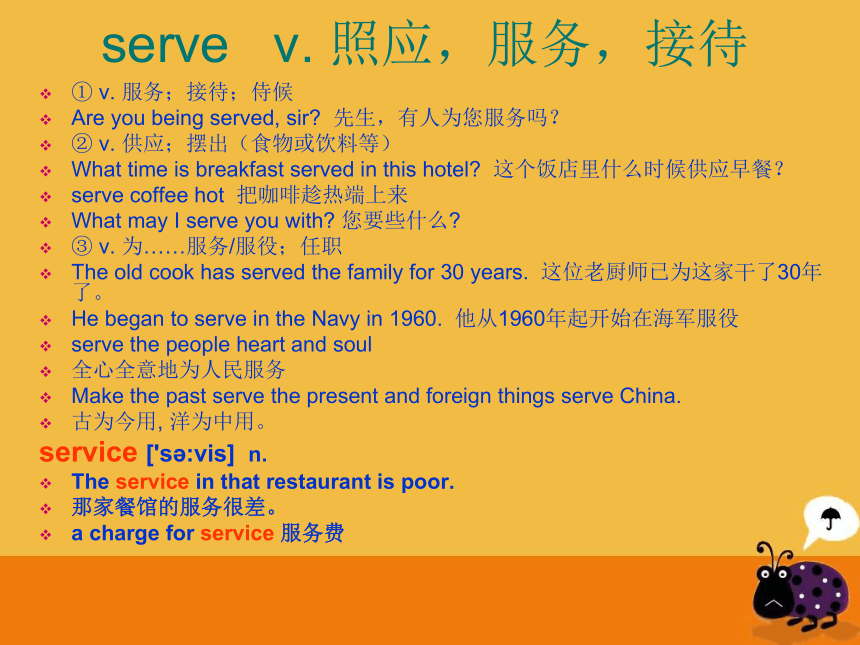
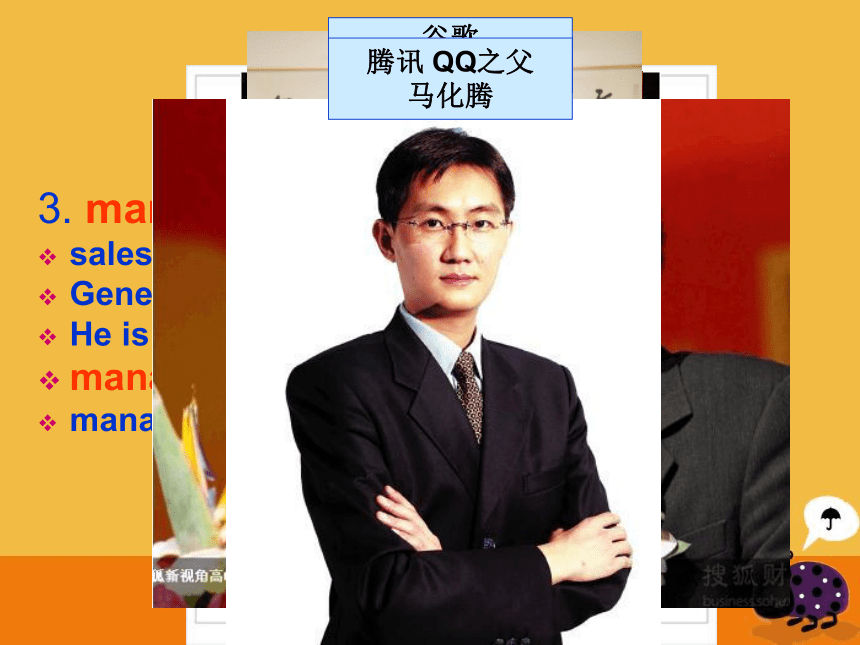

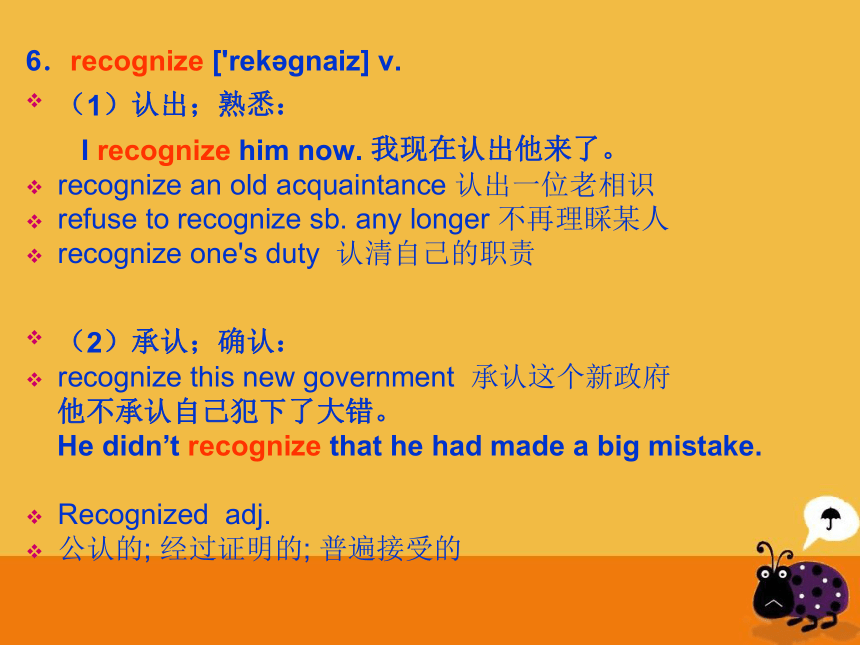
文档简介
(共28张PPT)
Lesson 121
Key words&expressions
customer n. 顾客
forget v. 忘记
manager n. 经理
serve v. 照应,服务,
接待
counter n. 柜台
recognize v. 认出
Key words&expressions
1. Customer ['k st m ] n. 顾客
custom 风俗
customs 海关
有顾客customer的地方,肯定就有 shop assistant /waiter/waitress
guest 旅馆的旅客
passenger 乘客
a regular customer 老顾客
顾客至上
Customer is god.
account customer立有存款帐的顾主
cash customer现金交易客户
charge customer赊销顾客
credit customers赊户, 信用顾客
regular customer 老主雇
a queer customer怪人
a tough customer 粗暴的[难对付的]家伙, 坚强的人, 身体结实健壮的人
2. forget [f ‘get] v.忘记(forgot/ forgotten)
forget to do 忘记要做…
forget doing sth 忘记已经做过…
大家感受一下这两个句子:
①I forget to send an email to him. (忘记要发邮件,邮件还没发)
②I forget sending an email to him.(忘记已经发过了,邮件已经发出了)
反义词 remember
serve v. 照应,服务,接待
① v. 服务;接待;侍候
Are you being served, sir 先生,有人为您服务吗?
② v. 供应;摆出(食物或饮料等)
What time is breakfast served in this hotel 这个饭店里什么时候供应早餐?
serve coffee hot 把咖啡趁热端上来
What may I serve you with 您要些什么
③ v. 为……服务/服役;任职
The old cook has served the family for 30 years. 这位老厨师已为这家干了30年了。
He began to serve in the Navy in 1960. 他从1960年起开始在海军服役
serve the people heart and soul
全心全意地为人民服务
Make the past serve the present and foreign things serve China.
古为今用, 洋为中用。
service ['s :vis] n.
The service in that restaurant is poor.
那家餐馆的服务很差。
a charge for service 服务费
3. manager ['m nid ] n. 经理
sales manager 销售经理
General Manager 总经理
He is our manager.
manage ['m nid ] v. 管理
manage a company 经营公司
阿里巴巴 雅虎中国
马云
搜狐
张朝阳
微软 盛大
唐骏
谷歌
李开复
腾讯 QQ之父
马化腾
Key words&expressions
5.counter ['kaunt ] n. 柜台
at the jewelry counter
checkout counter
在珠宝部
付帐柜台
6.recognize ['rek ɡnaiz] v.
(1)认出;熟悉:
I recognize him now. 我现在认出他来了。
recognize an old acquaintance 认出一位老相识
refuse to recognize sb. any longer 不再理睬某人
recognize one's duty 认清自己的职责
(2)承认;确认:
recognize this new government 承认这个新政府
他不承认自己犯下了大错。
He didn’t recognize that he had made a big mistake.
Recognized adj.
公认的; 经过证明的; 普遍接受的
⑵
⑴
⑶
⑷
⑸
Language points
1. I bought two expensive dictionaries here half an hour ago, but I forgot to take them with me.
take sth with sb 把某物带走
我去那个村庄的时候我随身带了一些药。
I took some medicine with me when I went to the village.
take sb sth = take sth to sb 把某物拿去给某人
I’ll take some presents to my friends in Beijing.
= I’ll take my friends in Beijing some presents.
dictionary
later
2.Who served you, sir
The lady who is standing behind the counter.
served是serve的过去式,“服务”
我会全心全意为人民服务的。
I’ll serve the people with heart and soul.
定语从句
3.Which books did you buy
The books which are on the counter.
which 指在一定范围内的哪个(些)
which 既可用来指人,又可用来指物
定语从句
哦~~~~
4. Did you serve this gentleman half an hour ago, Caroline
He says he’s the man who bought these books.
间接引语
定语从句
5. I can’t remember.
The man who I served was wearing a hat.
wear 穿(表示状态)
put on 穿上(强调动作)
定语从句
是吗?
6. Have you got a hat, sir
Yes, I have.
Would you put it on, please
All right.
Would you… 请你…好吗?
All right=OK.表示“好吧,行”
也可表示(身体)好,无恙
That’s all right.表示“没有关系”,用于回答sorry.
That’s all.表示“就这些了”。
That’s right.表示“对了,说得对”。
do you have a hat
定义:在复合句中修饰名词和代词的从句叫做定语从句。
被定语从句修饰的名词或代词是先行词。定语从句必须放在先行词之后。
定语从句要由关联词:关系代词who, whom, that,which或关系副词when, where等引导。
The student who answered the question was peter.
回答问题的那个学生叫Peter.
Grammars
用法
1、关系代词:who, whom, whose, which, that
①(先行词)人 + who/that + 动词(作主语)
The man who has white hair is Mr.White.
②(先行词)人+whose + 名词 + 动词(作定语)
I have a friend whose father is a teacher.
③(先行词)人+ who/whom/that + 及物动词/不及物动词 + 介词(做宾语)
The man we met is my uncle.
④(先行词)物 + which/that + 动词(作主语)
which是指人以外的生命或没有生命的东西
This is the bird which always sings at night.
⑤(先行词)物+which/that + 主语 + 及物动词(作宾语)
This is the letter I received yesterday.
How is it formed
被修饰的名词、代词叫做先行词,
定语从句常跟在先行词之后,由关系代词或关系副词引导。
The lady who is standing behind the counter.
antecedent 先行词
被定语从句修饰的名词、代词称为先行词。如“The man”、“The book”。如“那个穿着西装的人是我爸爸”这就是一个定语从句。
The man who wears the suit is my dad.
who, whom, that用来指人
这些词代替指人,“whom”作宾语指人,"who"和“that”既可作主语又可作宾语(作宾语可以省略),可以指人也可以指物。在从句中所起作用如下:
(1)Is he the man who/that wants to see you 他是那个想见你的男人吗?(who/that在从句中作主语)
(2)He is the man whom/ that I saw yesterday. 他就是我昨天见的那个人。(whom/that在从句中作宾语)
(3)The man whom you spoke to just now is our English teacher. 你刚刚说话的那个男人是我们的英语老师。
which、that 用来指物
(用作主语、宾语,作宾语时可以省略),例如:
(1)The cups (which / that) are on the shelf are pretty. (which / that在从句中作主语)
(2)He has found the key (which / that) he lost yesterday.(which / that在从句中作宾语)
穿着红色连衣裙的那个女人是我妈妈。
这是我昨天买的那块手表。
1.The boy who is standing under the tree is my brother.
2.The woman who wears a red dress is my mother.
3.This is the watch which I bought yesterday.
正站在树下的那个男孩儿是我哥哥。
关系代词who, whom的用法
二者都用于指人。who在定语从句中做主语,宾语都可以。whom在定语从句中只能做宾语。
Eg. 1. 他是来自美国的那个男孩。
He is the boy
who comes from America
.
2. 她是每天读英语的那个女孩
She is the girl
who reads English every day.
3. 他是住在隔壁的那个男子。
He is the man
who lives next door.
关系词that的用法:
关系词that既可以用来指人,也可以用来指物。
即当先行词无论是人或是物的时候都可以用that。
1.The man ____ came this morning had a funny
face.
2.I don’t like the house______ he lives in.
3.This is the bridge _____ he built last year.
4.I don’t know the man___________she is talking
to.
5.Did you buy the car ______ he likes very much
that
that
that
that
that
练习:用适当的关系词填空
1.The man ____ came this morning had a funny face.
2.I don’t like the house______ he lives in.
3.This is the bridge _____ he built last year.
4.I don’t know the man___________she is talking to.
5.Did you buy the car ______ he likes very much
6.The boy __________ she is looking after is her brother.
7.Do you know the cinema _____ near the bus-stop
8.The nurse ___________we are talking about speaks English well.
9.The book ______ you want to buy is not very good.
10.The doctor __________ she called yesterday is my father.
who
which
which
who/whom
which
who/whom
which
who/whom
which
who/whom
You are the first person ____I want to see.
This is the second book ____ I bought this week.
He is the first person_____ arrived at the finishing line.
that
that
that
homework
1. To finish the exercises after the text.
2. To practise the structures learned during the class.
Lesson 121
Key words&expressions
customer n. 顾客
forget v. 忘记
manager n. 经理
serve v. 照应,服务,
接待
counter n. 柜台
recognize v. 认出
Key words&expressions
1. Customer ['k st m ] n. 顾客
custom 风俗
customs 海关
有顾客customer的地方,肯定就有 shop assistant /waiter/waitress
guest 旅馆的旅客
passenger 乘客
a regular customer 老顾客
顾客至上
Customer is god.
account customer立有存款帐的顾主
cash customer现金交易客户
charge customer赊销顾客
credit customers赊户, 信用顾客
regular customer 老主雇
a queer customer怪人
a tough customer 粗暴的[难对付的]家伙, 坚强的人, 身体结实健壮的人
2. forget [f ‘get] v.忘记(forgot/ forgotten)
forget to do 忘记要做…
forget doing sth 忘记已经做过…
大家感受一下这两个句子:
①I forget to send an email to him. (忘记要发邮件,邮件还没发)
②I forget sending an email to him.(忘记已经发过了,邮件已经发出了)
反义词 remember
serve v. 照应,服务,接待
① v. 服务;接待;侍候
Are you being served, sir 先生,有人为您服务吗?
② v. 供应;摆出(食物或饮料等)
What time is breakfast served in this hotel 这个饭店里什么时候供应早餐?
serve coffee hot 把咖啡趁热端上来
What may I serve you with 您要些什么
③ v. 为……服务/服役;任职
The old cook has served the family for 30 years. 这位老厨师已为这家干了30年了。
He began to serve in the Navy in 1960. 他从1960年起开始在海军服役
serve the people heart and soul
全心全意地为人民服务
Make the past serve the present and foreign things serve China.
古为今用, 洋为中用。
service ['s :vis] n.
The service in that restaurant is poor.
那家餐馆的服务很差。
a charge for service 服务费
3. manager ['m nid ] n. 经理
sales manager 销售经理
General Manager 总经理
He is our manager.
manage ['m nid ] v. 管理
manage a company 经营公司
阿里巴巴 雅虎中国
马云
搜狐
张朝阳
微软 盛大
唐骏
谷歌
李开复
腾讯 QQ之父
马化腾
Key words&expressions
5.counter ['kaunt ] n. 柜台
at the jewelry counter
checkout counter
在珠宝部
付帐柜台
6.recognize ['rek ɡnaiz] v.
(1)认出;熟悉:
I recognize him now. 我现在认出他来了。
recognize an old acquaintance 认出一位老相识
refuse to recognize sb. any longer 不再理睬某人
recognize one's duty 认清自己的职责
(2)承认;确认:
recognize this new government 承认这个新政府
他不承认自己犯下了大错。
He didn’t recognize that he had made a big mistake.
Recognized adj.
公认的; 经过证明的; 普遍接受的
⑵
⑴
⑶
⑷
⑸
Language points
1. I bought two expensive dictionaries here half an hour ago, but I forgot to take them with me.
take sth with sb 把某物带走
我去那个村庄的时候我随身带了一些药。
I took some medicine with me when I went to the village.
take sb sth = take sth to sb 把某物拿去给某人
I’ll take some presents to my friends in Beijing.
= I’ll take my friends in Beijing some presents.
dictionary
later
2.Who served you, sir
The lady who is standing behind the counter.
served是serve的过去式,“服务”
我会全心全意为人民服务的。
I’ll serve the people with heart and soul.
定语从句
3.Which books did you buy
The books which are on the counter.
which 指在一定范围内的哪个(些)
which 既可用来指人,又可用来指物
定语从句
哦~~~~
4. Did you serve this gentleman half an hour ago, Caroline
He says he’s the man who bought these books.
间接引语
定语从句
5. I can’t remember.
The man who I served was wearing a hat.
wear 穿(表示状态)
put on 穿上(强调动作)
定语从句
是吗?
6. Have you got a hat, sir
Yes, I have.
Would you put it on, please
All right.
Would you… 请你…好吗?
All right=OK.表示“好吧,行”
也可表示(身体)好,无恙
That’s all right.表示“没有关系”,用于回答sorry.
That’s all.表示“就这些了”。
That’s right.表示“对了,说得对”。
do you have a hat
定义:在复合句中修饰名词和代词的从句叫做定语从句。
被定语从句修饰的名词或代词是先行词。定语从句必须放在先行词之后。
定语从句要由关联词:关系代词who, whom, that,which或关系副词when, where等引导。
The student who answered the question was peter.
回答问题的那个学生叫Peter.
Grammars
用法
1、关系代词:who, whom, whose, which, that
①(先行词)人 + who/that + 动词(作主语)
The man who has white hair is Mr.White.
②(先行词)人+whose + 名词 + 动词(作定语)
I have a friend whose father is a teacher.
③(先行词)人+ who/whom/that + 及物动词/不及物动词 + 介词(做宾语)
The man we met is my uncle.
④(先行词)物 + which/that + 动词(作主语)
which是指人以外的生命或没有生命的东西
This is the bird which always sings at night.
⑤(先行词)物+which/that + 主语 + 及物动词(作宾语)
This is the letter I received yesterday.
How is it formed
被修饰的名词、代词叫做先行词,
定语从句常跟在先行词之后,由关系代词或关系副词引导。
The lady who is standing behind the counter.
antecedent 先行词
被定语从句修饰的名词、代词称为先行词。如“The man”、“The book”。如“那个穿着西装的人是我爸爸”这就是一个定语从句。
The man who wears the suit is my dad.
who, whom, that用来指人
这些词代替指人,“whom”作宾语指人,"who"和“that”既可作主语又可作宾语(作宾语可以省略),可以指人也可以指物。在从句中所起作用如下:
(1)Is he the man who/that wants to see you 他是那个想见你的男人吗?(who/that在从句中作主语)
(2)He is the man whom/ that I saw yesterday. 他就是我昨天见的那个人。(whom/that在从句中作宾语)
(3)The man whom you spoke to just now is our English teacher. 你刚刚说话的那个男人是我们的英语老师。
which、that 用来指物
(用作主语、宾语,作宾语时可以省略),例如:
(1)The cups (which / that) are on the shelf are pretty. (which / that在从句中作主语)
(2)He has found the key (which / that) he lost yesterday.(which / that在从句中作宾语)
穿着红色连衣裙的那个女人是我妈妈。
这是我昨天买的那块手表。
1.The boy who is standing under the tree is my brother.
2.The woman who wears a red dress is my mother.
3.This is the watch which I bought yesterday.
正站在树下的那个男孩儿是我哥哥。
关系代词who, whom的用法
二者都用于指人。who在定语从句中做主语,宾语都可以。whom在定语从句中只能做宾语。
Eg. 1. 他是来自美国的那个男孩。
He is the boy
who comes from America
.
2. 她是每天读英语的那个女孩
She is the girl
who reads English every day.
3. 他是住在隔壁的那个男子。
He is the man
who lives next door.
关系词that的用法:
关系词that既可以用来指人,也可以用来指物。
即当先行词无论是人或是物的时候都可以用that。
1.The man ____ came this morning had a funny
face.
2.I don’t like the house______ he lives in.
3.This is the bridge _____ he built last year.
4.I don’t know the man___________she is talking
to.
5.Did you buy the car ______ he likes very much
that
that
that
that
that
练习:用适当的关系词填空
1.The man ____ came this morning had a funny face.
2.I don’t like the house______ he lives in.
3.This is the bridge _____ he built last year.
4.I don’t know the man___________she is talking to.
5.Did you buy the car ______ he likes very much
6.The boy __________ she is looking after is her brother.
7.Do you know the cinema _____ near the bus-stop
8.The nurse ___________we are talking about speaks English well.
9.The book ______ you want to buy is not very good.
10.The doctor __________ she called yesterday is my father.
who
which
which
who/whom
which
who/whom
which
who/whom
which
who/whom
You are the first person ____I want to see.
This is the second book ____ I bought this week.
He is the first person_____ arrived at the finishing line.
that
that
that
homework
1. To finish the exercises after the text.
2. To practise the structures learned during the class.
同课章节目录
